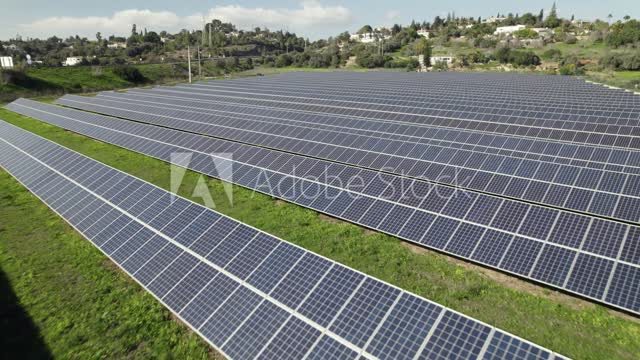Premium Only Content

Photovoltaic with an overall efficiency of 83% via MXenes nanofluid
UK researchers have demonstrated a photovoltaic thermal panel that utilizes an MXene/water nanofluid for heat transfer. They said the nanofluid is not only able to improve the thermal and electrical performance of the panel, but also to reduce its size by 14.5%.
AUGUST 1, 2022 EMILIANO BELLINI
Schematic of the proposed PV/T system.
Image: Ulster University, Cleaner Energy Systems, Creative Commons License CC BY 4.0
Scientists at the Ulster University in the United Kingdom have demonstrated a photovoltaic thermal panel (PVT) that relies on a heat transfer fluid (HTF) based on water and two-dimensional transition metal carbides and nitrides known as MXenes. Earth-abundant MXenes compounds take their name from their graphene-like morphology and are made via selective etching of certain atomic layers from a bulk crystal known as MAX.
According to the researchers, the MNenes particles are able to considerably enhance the thermal conductivity of the base fluid and the heat transfer enhancement of the panel. Their numerical simulation was conducted on a module with a size of 1,640 mm × 200 mm × 5 mm and a sheet-and-tube absorber geometry consisting of a glass cover, an ethylene vinyl acetate (EVA) sheet, a photovoltaic panel, another EVA sheet, a Tedlar sheet, an absorber sheet, and an absorber tube.
The UK group considered different varying concentrations of MXene nanofluid at 0.01, 0.1, and 0.2 wt%. “The upper limit of MXene nanofluid concentration was selected from literature based on the optimum concentration that generates better thermophysical property improvement with a minimum viscosity enhancement,” it explained.
The academics compared the performance of the module with that of a panel with a heat transfer fluid based on water and a module with a fluid using ethylene glycol (Eg). They performed the simulation by varying mass flow rates while keeping constant inlet temperature, and solar radiation. Thermal efficiency, electrical efficiency, heat transfer coefficient (HTC), and pressure drop were the key parameters of their analysis.
The panel based on MXenes showed the highest percentage enhancement in thermal efficiency by 17% over the water-based system. “The highest thermal efficiency of 67.49% was reported with 0.2 wt% MXene nanofluids,” the scientists said. “Around 63% and 60.4% thermal efficiency were shown by MXene nanofluids of 0.1 and 0.01 wt%, respectively. Increasing the mass flow rate of 0.2 wt% nanofluids by 60 kg−1 produced about a 21% increase in the thermal efficiency of the system.”
The MXenes fluid also contributed to the highest increase in photovoltaic efficiency, which was 15.94% and was achieved by a 0.2 wt% nanofluid concentration. “However, the corresponding increase in electrical efficiency of N-PV/T was only about 0.65%,” the research team noted. “The highest overall energy efficiency attained by N-PV/T with 0.01, 0.1, and 0.2 wt% MXene nanofluid was calculated to be around 76, 78, and 83% at 90 kgh−1. Also, the outlet temperature was found to decrease with the flow rate.”
About Us https://bit.ly/3GUPFOa
Contact: +919942258153 kvk.subadhra@gmail.com
Thank You Very Much for Sharing YourValuable Thoughts
-
 31:49
31:49
Rocco Taco Mining
3 years agoNICEHASH Tuning For Efficiency with Quickminer OCTune
15 -
 0:27
0:27
WXYZ
3 years agoDetroit Lions select Michigan DE Aidan Hutchinson with 2nd overall pick
16 -
 LIVE
LIVE
LFA TV
1 hour agoLFA TV ALL DAY STREAM - THURSDAY 8/21/25
10,010 watching -
 LIVE
LIVE
The Bubba Army
22 hours agoAnother LopSided Jake Paul Fight? - Bubba the Love Sponge® Show | 8/21/25
9,587 watching -
 1:02:42
1:02:42
Dialogue works
1 day ago $2.33 earnedJohn Helmer: Trump Ditches Ceasefire? Despite EU & Zelensky Pressure
39.3K18 -
 10:48
10:48
Nikko Ortiz
19 hours agoDont Watch These TikToks
70.3K13 -
 10:17
10:17
MattMorseTV
18 hours ago $14.06 earnedTrump's DOJ just DROPPED a NUKE.
79.2K91 -
 2:09:32
2:09:32
Side Scrollers Podcast
21 hours agoStreamer DIES Live On Air + Your Food is Poison + Xbox Announces $900 Handheld | Side Scrollers Live
32.9K13 -
 15:32
15:32
GritsGG
17 hours agoFull Auto ABR Sniper Support! Most Winning Quad Win Streaking!
17.9K3 -
 7:42
7:42
The Pascal Show
16 hours ago $1.35 earnedBREAKING! Police Provide UPDATE In Emmanuel Haro's Case! Is Jake's Lawyer Lying To Us?!
22.7K1